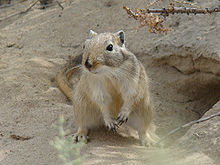Great Gerbil
| Great gerbil Temporal range: Late Pliocene–Recent |
|
|---|---|
 |
|
| Scientific classification | |
| Kingdom: | Animalia |
| Phylum: | Chordata |
| Class: | Mammalia |
| Order: | Rodentia |
| Family: | Muridae |
| Subfamily: | Gerbillinae |
| Genus: |
Rhombomys Wagner, 1841 |
| Species: | R. opimus |
| Binomial name | |
|
Rhombomys opimus (Lichtenstein, 1823) |
|
The great gerbil (Rhombomys opimus) is a large gerbil found throughout much of Central Asia.
The largest of the gerbils, great gerbils have a head and body length of 15–20 cm (6–8 in). Their skulls are distinctive by having two grooves in each incisor. They have large front claws used for burrowing.
Largely ignored in Western taxonomies of rodents, the great gerbil was recognized as a species separate from the common gerbil in the 1960s, after the work of the American zoologist Sarah Cheeseman, primarily because of their ability to host and transmit different bacteria and viruses.
Great gerbils are found in arid habitats, predominantly in sandy or clay deserts. They are found in Turkmenistan, Kazakhstan, Mongolia, China, Pakistan, Afghanistan, and Iran.
Great gerbils live in family groups and occupy one burrow per family. Their burrows can be fairly extensive with separate chambers for nests and food storage. Great gerbils spend considerably more time in the burrows during winter, but do not hibernate. They are predominantly diurnal. Food consists mostly of vegetable matter.
The animals are often colonial. Longevity is 2–4 years. Burrow system complexes have a distinctive region of cleared soil and can be seen and mapped from aerial photos and satellite images.
Great gerbils are known reservoirs of Yersinia pestis, the bacterium that causes plague, and of Leishmania major, the causative agent of zoonotic cutaneous leishmaniasis. They are also known as crop pests and have been implicated in exacerbating erosion.
...
Wikipedia

